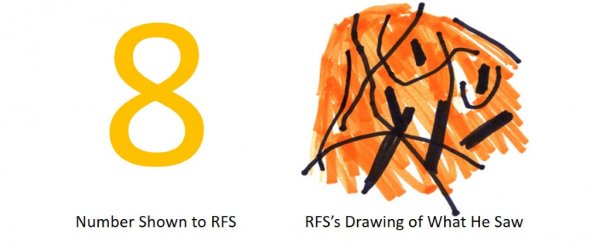What comes first – the squiggle or the inability to see numbers? That's what scientists have had to investigate in the unusual case of an engineering geologist who suffered a neurological injury, and suddenly couldn't perceive the numbers 2-9.
But here's the thing – he could still understand letters, symbols, and even the numbers 0 and 1.
"When he looks at a digit, his brain has to 'see' that it is a digit before he can not see it - it's a real paradox," said senior author, Johns Hopkins University cognitive scientist Michael McCloskey.
"In this paper what we did was to try to investigate what processing went on outside his awareness."
The patient - anonymously referred to in the case study as RFS - was diagnosed with a rare degenerative brain disease called corticobasal syndrome caused by significant damage to two areas of the brain: the cortex and basal ganglia.
Most people who have this disease suffer symptoms such as memory issues, muscle spasms, and difficulty walking. But as well as those normal symptoms, RFS also lost his ability to perceive, describe, or even copy most regular old Arabic numerals.
In a video released by the researchers, RFS tries to copy an orange '8', but instead, he draws what he describes as spaghetti, with an orange background.
In another experiment, the team tried to put pictures or words in or near large block numbers. The patient could easily see the pictures in equivalent letters, but couldn't see the pictures placed inside the numbers.
While this sounds unbelievable, the medical team carefully weighed up a range of possibilities, concluding the man was genuinely experiencing the strange perceptual anomaly.
"Given the rare form of RFS' metamorphopsia, how can we be sure that his deficit is genuine? With any unusual deficit, there is the possibility that the underlying dysfunction is psychiatric, psychogenic, or 'functional', rather than an impairment of basic perceptual/cognitive processes," the team writes in their paper.
"We believe this unlikely in the present case for multiple reasons … At the time of our study RFS was seeing a psychiatrist for help in adjusting to his condition, and the psychiatrist had no suspicion that any of his perceptual, cognitive, or physical symptoms reflected a functional disorder. In addition, RFS' performance in two-choice discrimination was not below chance, as is often found in cases of malingered deficits."
The team worked with the man for nearly eight years – even creating a surrogate number system that RFS was able to use to continue his job until his retirement a few years later.

But the researchers really only understood what was actually happening when they studied RFS's brain using electroencephalography (EEG).
When RFS looked at a number with a face or a word inside of it, he couldn't tell there was something in there, but the researchers think his brain could.
"He was completely unaware that a word was there, yet his brain was not only detecting the presence of a word, but identifying which particular word it was, such as 'tuba'," said Harvard University cognitive scientist Teresa Schubert.
In neurology, it's normally assumed that the neural activity the research team was seeing on the EEG is what causes the visual awareness, but this research suggests that additional processing is required – and it's only this last step that RFS doesn't seem to have any more.
"His brain detected the faces in the digits without his having any awareness of them," said VA Boston Healthcare's David Rothlein.
"These results show that RFS's brain is performing complex processing in the absence of awareness."
The research has been published in PNAS.
